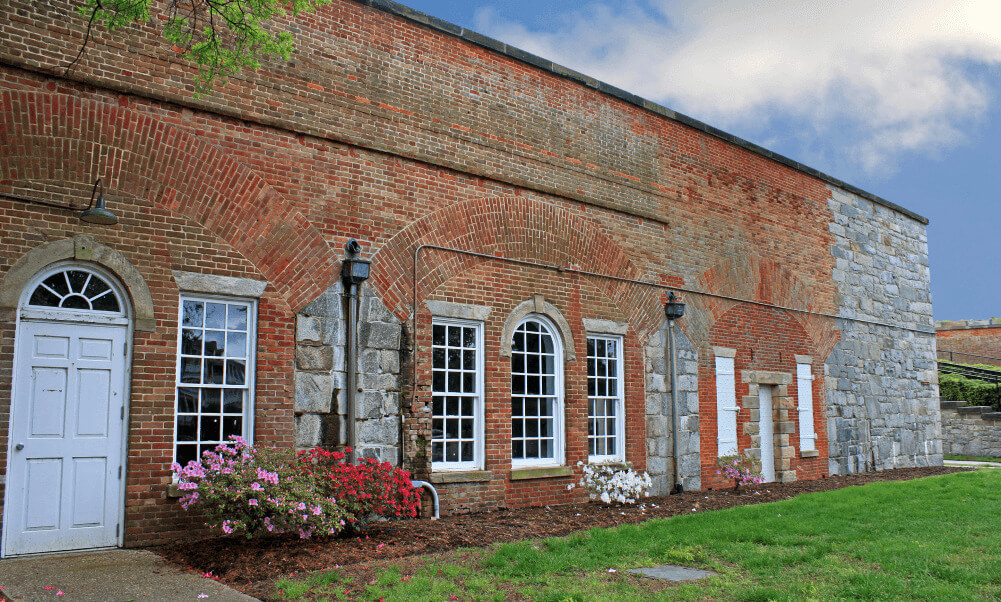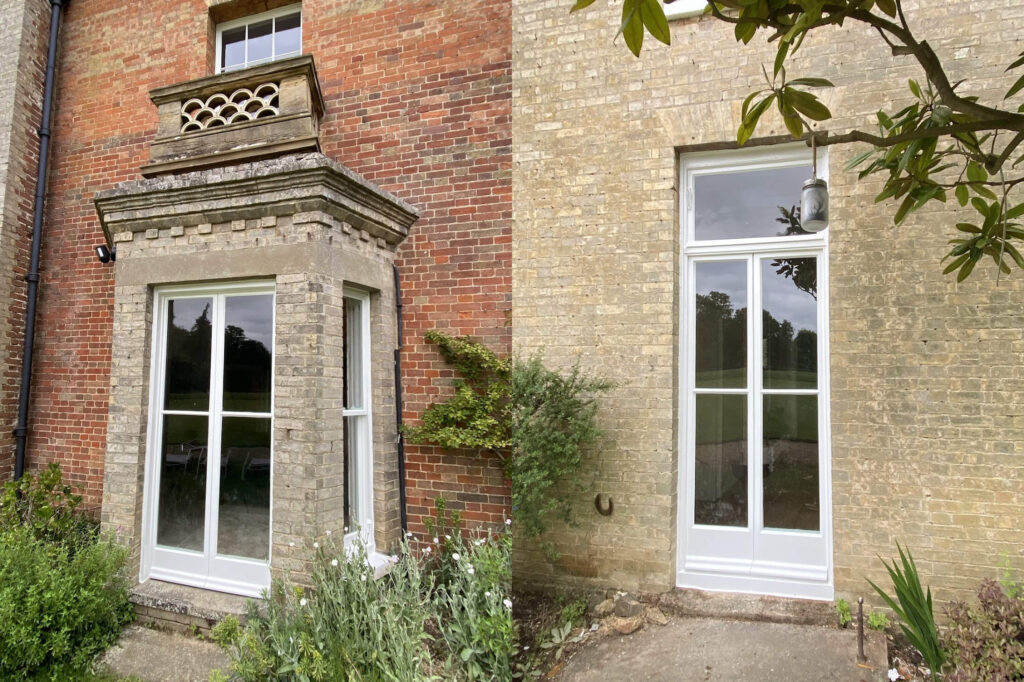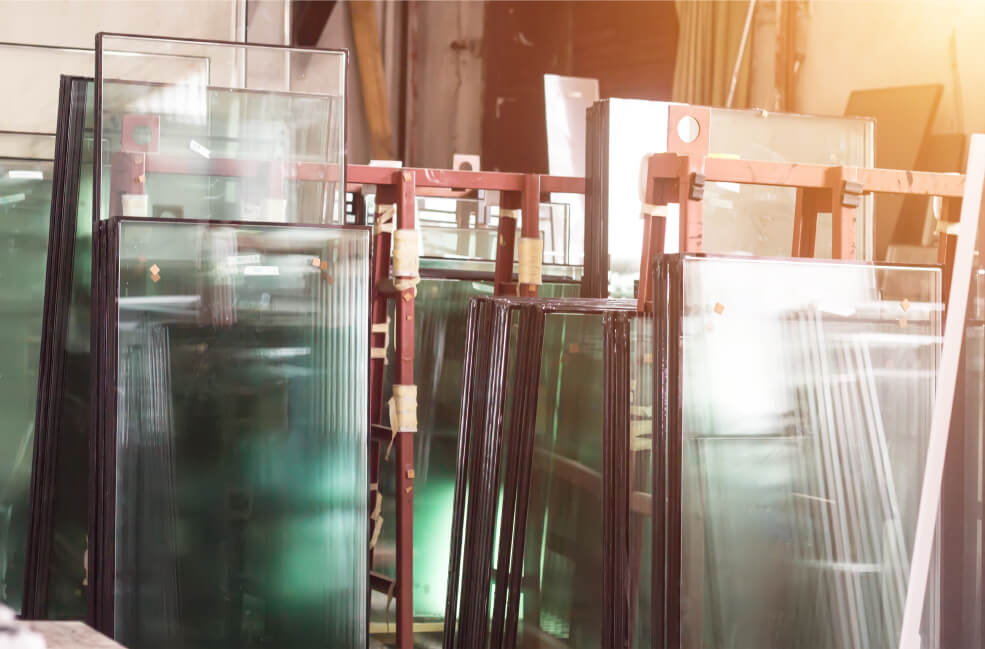
The danger of glass
Understanding safety glass regulations is essential, as glass can be a hazardous material when it shatters, causing severe injuries. With stringent regulations in place, safety glass is now a requirement in many areas of the home to minimize these dangers.
Over the years, glass has become significantly stronger. Double glazing reduces the likelihood of smashed glass. However, glass will never be completely safe from breaking.

The development of safety glass has helped reduce the impact of broken glass. This innovation makes our living environments much safer.
Safety glass regulations are designed to protect homeowners from possible injuries and harm caused by sharp shards of shattered glass.
This blog explains everything about safety glass. Learn what it is, where it’s needed, and the different types available. Let’s start by explaining what safety glass is.
What is safety glass?
Safety glass is specially toughened and strengthened to protect people. This type of glass was designed to reduce the risk of injury if it breaks or shatters.
Safety glass is meant to keep people safe during accidents. It helps to reduce the risks that come with broken glass, either through prevention or damage limitations.
What is safety glass used for?
Safety glass is used in any area considered a “critical location.” In these places, if the glass breaks, it could cause serious harm or injury. Its primary purpose is to enhance safety by reducing the likelihood of injury when breakage occurs. Here are the main applications of safety glass:
- Safety glass is used in windows that are installed at low levels, typically below 800mm from the floor, to protect against accidental impacts.
- All glazed areas within doors, especially those below 1500mm from floor level, must be made from safety glass to prevent injury in case of accidental breakage.
- Safety glass is used in balustrades, ensuring the glass panels are strong enough to withstand impacts and prevent falls in stairways and balconies.
- In modern architectural designs, glass stairs often feature safety glass to provide the necessary strength and durability while maintaining a sleek appearance.
- Safety glass is used in glass flooring applications, offering a robust solution that can handle the weight and stress of foot traffic while preventing injury.
- Items such as shower screens, tables, and worktops are made from safety glass to minimize the risk of injury from broken glass in high-use areas.
Three types of safety glass
All safety glass isn’t the same and can be split down into three different types of glass – laminated, toughened and wired. All of these have different qualities and reduce the risk of any breakage to keep you safe.
Laminated glass
There are two ways in which you can create safety glass, and the first is through lamination. Laminated glass is when two or more layers of glass are sandwiched together by an extremely tough plastic interlayer.
This is often used on car windscreens.
The plastic interlayer holds the smashed glass in place so that the glass doesn’t smash as easily and keeps the fragments in place.
This reduces the damage and stops shards from falling from the glass, and keeps it in place, providing time for a replacement to be found.
Toughened vacuum glazing
Toughened double glazing combines the durability of toughened glass with exceptional thermal insulation, achieved by sealing two glass panes with a vacuum space between them.
The vacuum layer boosts energy efficiency and greatly reduces heat transfer. This makes it ideal for installations needing both strength and insulation, such as in modernized heritage properties or energy-conscious buildings.
Toughened glass, also called tempered glass, is significantly stronger than annealed glass or laminated glass of the same thickness.
Toughened glass is made from a tempering process where ordinary glass is repeatedly exposed to intense heating followed by rapid cooling.
This process strengthens the glass, giving it higher protection against impacts. As a result, it can withstand greater loads and requires a stronger impact to shatter compared to regular glass.
When broken, toughened glass fragments into small granular pieces minimizing injury risk. Toughened vacuum glazing is ideal for external windows and doors. It provides both impact resistance and essential thermal performance.
The difference between toughened and laminated glass
Toughened glass and laminated glass are different types of safety glass, each with unique characteristics and applications. Here is a comparison to help you understand their differences and uses.
| Feature | Laminated Glass | Toughened vacuum glazing |
|---|---|---|
| Structure | Multiple layers of glass combined with a PVB interlayer to hold fragments together upon breakage | Two toughened panes of glass with a vacuum layer in between |
| Safety | The PVB layer prevents complete shattering, holding shards in place to reduce injury risk | When breaks, splits into small blunt pieces to minimize injury risk |
| Thermal insulation | Moderate, with sound and UV insulation | Excellent, due to the vacuum barrier between panes |
| Applications | Car windscreens, skylights, secure areas requiring high security | External windows, doors, and areas needing strength and insulation |
| Advantages | Offers sound insulation, UV protection, and remains intact when broken | High impact resistance with superior insulation for energy savings |
| Drawbacks | Costs higher than standard glass, with slightly reduced visual clarity | Higher cost compared to standard toughened or laminated glass |
| Best for | High-security areas with noise reduction and UV protection needs | High-impact areas where energy efficiency and noise reduction are priorities |
Wired safety glass
Wired glass is made when a wire mesh is embedded into the glass during production to reinforce it.
Like laminated glass, the wire mesh helps retain the glass and stops it from going everywhere.

Wired safety glass is also popular due to its fire rating. It’s commonly used in locations like schools and universities.
Where is safety glass required?
There are many places in a UK home where Building Regulations require you to have safety glass to protect people from injuries. Here is where you will need safety glasses in the home.
Door glazing
Glass which is partially within 1500mm of floor level, must be safety glass. This means that glazing found in doors usually needs to be made from safety glass.
Glazing adjacent to doors
The same rule for height applies to door sidelights. Glazing adjacent doors which are less than 1500mm from the floor must be safety glass. Also, glazing which is wholly or partially within 300mm of the edge of a door must be safety glass too. This means that sidelights will always need to be made with safety glass to help protect homeowners from injury.
Low-level glazing
Another glazing, which is 800mm from floor level. This includes windows that aren’t 300mm from a door but are less than 800mm from the floor must use safety glass.
Bathroom areas
Bathroom areas also need safety glass as there is a risk of slipping on wet surfaces and a potential for damage to be caused. This means that all glazed features in bathrooms, such as shower screens and mirrors, must be made from safety glass.
Protective barriers
Protective barriers, like balconies and balustrades, are commonly found on landings and stairways. These areas require safety glass due to heavy foot traffic.
Furniture and cabinets
All glass furniture must have safety glass, which could include tables, cabinets, shelving units as well as mirrors. You may have noticed if you’ve ever broken a mirror or glass table that safety glass is normally used to keep people safe.
Other critical locations
These are the required locations for safety glass in typical households. However, some places should consider using safety glass throughout. In places of high risk, such as schools, gyms, and colleges, it’s recommended that all planes use safety glass in order to keep those people safe. Compliance with internal doors safety glass regulations is crucial to ensure maximum protection in these areas.
How do I identify safety glass?
If you’ve moved into a property, the windows or glazed areas might already be installed. You may not know if they are made from safety glass or simply can’t remember.
It’s easy to tell if it’s safety glass once it has been smashed, but that is of course, not an appropriate way of checking.
If you are unsure whether or not it is safety glass, there are a few things that you can check to see if it is or not.
Safety mark
The easiest way of finding out is if there is a safety mark on the pane of glass. The manufacturer’s logo and name should be on the glass, with a reference to a relevant product standard. For toughened glass, this is BS EN 12150, and for laminated glass, this is BS EN 14449.
If you can see this on the pane, then you know that it is made using safety glass.
Check the edges
If this logo is not present on the glass, then you can check the edges to see whether or not it is safety glass. Carefully run your finger along the edge, and if it is smooth and rounded, then it is likely to be toughened glass.
Look for imperfections
If you can see slight dimples, warping or bending of the glass, then this may be a good sign. These signs can occur in the healing process of tempered glass production and mean it is very likely that it is safe glass. The marks come from the tongs used during the healing process.
Tempered glass may also have very light scratches on it. This comes from small particles from the roller machine used in the tempering process melting and fusing into the surface of the glass. The debris drags around the glass and causes light scratches.
View through polarised lenses
If you look at the glass with polarised sunglasses on, dark, shady spots will appear on the surface. This is a clear sign that the glass is tempered, as the lines were formed from the machine during the tempering process.
At Scott James Sash Windows, we are experts in the restoration and repair of sash windows, which includes reglazing.
We specialise in providing modern solutions to those looking to maintain the traditional character of their sash windows and heritage properties.
We can also help those people looking for a glazing solution that reduces the risk of breakage for sash windows on traditional properties.
Read more articles

Double glazing retrofitting old cottage windows
Double glazing retrofitting old cottage windows
Toughened double glazing
Toughened double glazing
Is there a vacuum in double glazing?
Is there a vacuum in double glazing?